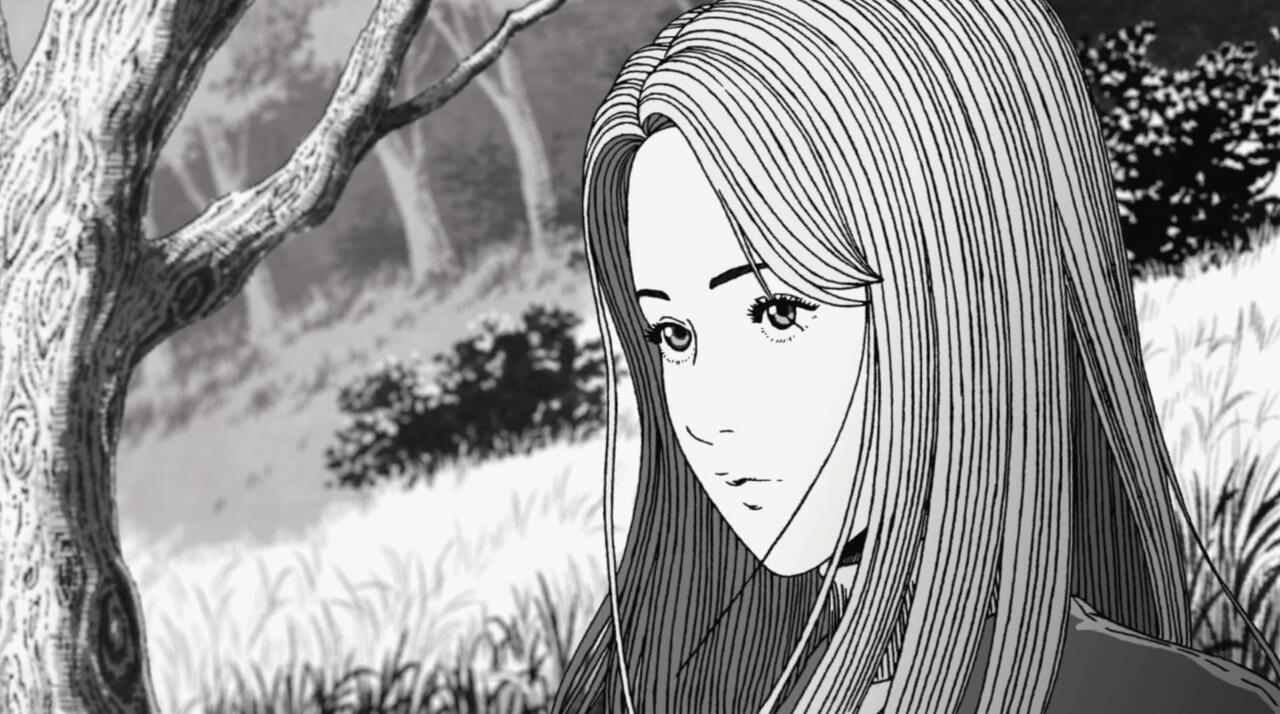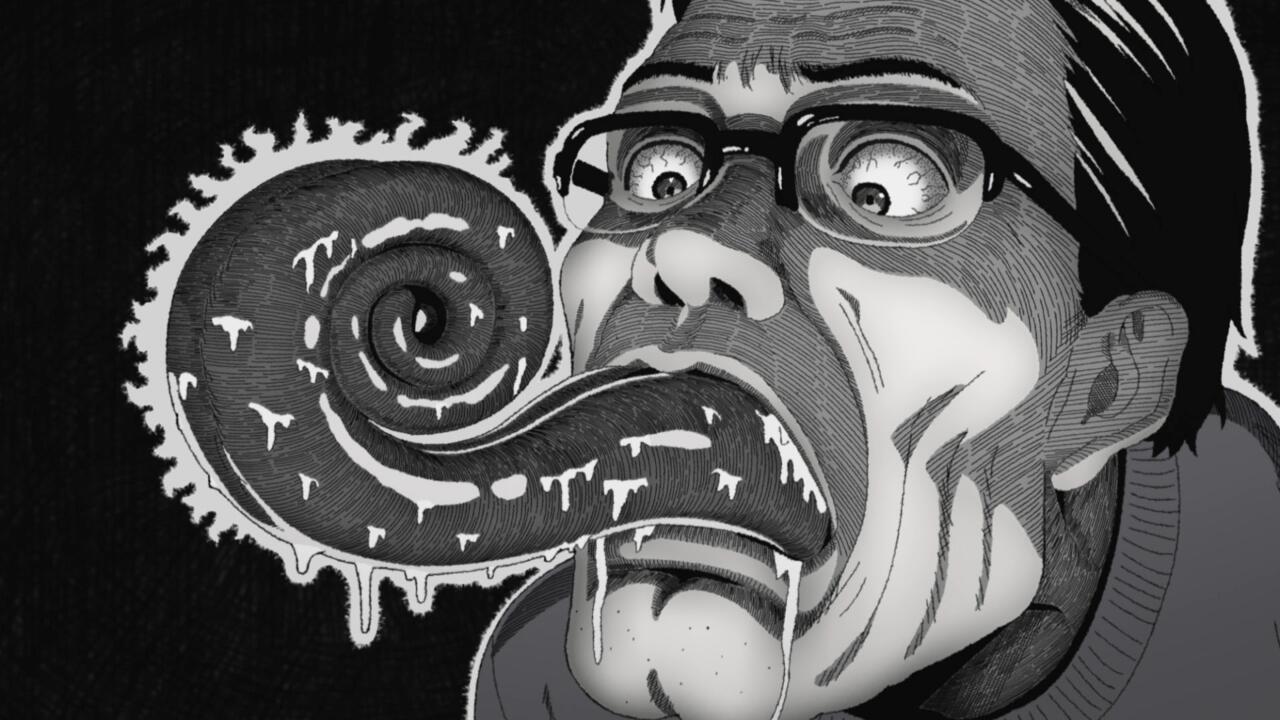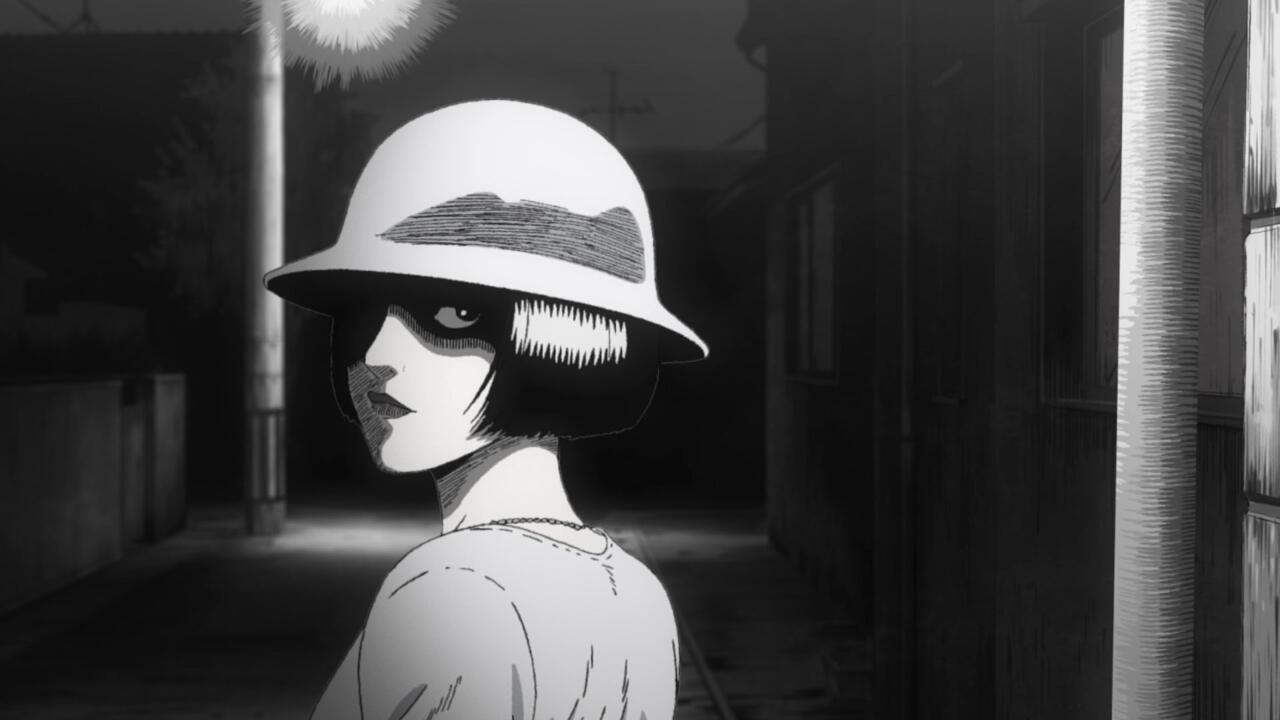
Among all of Junji Ito’s vast body of horror manga work, Uzumaki manages to be the most unsettling. Many of his stories concern elements of building dread, encroaching madness, and beautifully off-putting body horror, but few combine all three to the same effect as Uzumaki, where the concept of a spiral pattern infects and mutates the inhabitants of a small town in myriad awful ways.
Adult Swim’s anime adaptation of Uzumaki focuses on that unsettling feeling in its premiere episode, which was provided for review by Adult Swim. This introduction, for the most part, succeeds in bringing what makes Uzumaki so powerful in print to the screen. More than anything, it works to be painstakingly faithful to the manga in its art and style. It uses a black-and-white format to more closely match the book, a choice that serves it well, and some of the best images from the manga are transported exactly, or close to exactly, into the adaptation.

The concepts at work in Ito’s stories are simply, excellently messed up, and the anime version’s first episode works hard to capture them faithfully. Once it’s up on its feet, especially toward the end of the premiere, Uzumaki makes clear the reason for its existence: The addition of life and motion to the story can make Ito’s concepts creepy and awful in new and delightfully spooky ways.
Where the premiere episode stumbles, however, is in speeding toward that goal. At only four episodes, the series has a lot of disparate ground to cover in adapting 600 pages of Uzumaki, and that can give the sense that the anime is quickly sprinting from one iconic moment to the next.
The story centers on two characters, Kirie and Shuichi, who slowly start to realize that something awful is happening in their town as spiral patterns crop up more and more–and that the epicenter of that awfulness is Shuichi’s father. However, describing it as a single tale isn’t quite accurate. Uzumaki was originally published in a weekly magazine as a serialized story in 1998 and 1999, and sometimes functions more like a group of short stories set in the same town than as one larger narrative. The anime adaptation has that original format working against it somewhat, causing the early going to feel a bit hurried as it tries to get into the creepiness at the story’s heart as quickly as possible, while also setting up later narrative beats.
For the story of Shuichi’s family, which makes up a large part of the first episode, the anime covers it similarly to the manga, with Shuichi mostly summarizing what’s been happening to his dad. As a result, however, the series loses a degree of mounting dread and tension that would have better served the story in the animated medium, instead launching straight into a level of madness that’s a bit hard to follow.

The problem is that the power that Uzumaki already wields makes adapting it from the still images to motion something of a difficult feat. While it may seem like an easy transition to animate Ito’s work–the visual approach of the comic format is already pretty close to film and TV, after all–it’s actually very easy to lose what makes the manga scary. Ito’s images find horror in being incredibly detailed, often to the point of being disturbing, especially when you have the time to sit with and study them. Adding motion to some of those images, instead of making you imagine it yourself, can take them from being frighteningly strange to strangely goofy.
And that potential goofiness is exacerbated to some degree by the pacing. Shuichi’s dad is fully involved in spiral-based madness basically at the moment he’s mentioned in the show, so there’s just not much of an on-ramp into the story’s central conceit. The episode leaps directly from Shuichi discussing his dad’s mounting obsession to full-on body horror moments, and those would have been more effective with a little more time to build anxiety, develop the characters, and bring the audience fully into the anime’s world.
Thankfully, though, it isn’t always the case that strange skips over scary to bleed into goofy. By about the halfway point, when the series is intermixing different stories from the manga–including the third chapter, The Scar, which is one of its best–it’s able to pace things out in such a way that the creepiness builds in pressure toward a powerful intensity.
The show knows just how deeply horrific some of Ito’s iconic images from the manga are and leans on them heavily, bringing in the same intense level of detail that makes them hit so hard on the page. The show does little to bring you to Uzumaki’s world at first, but some of the images are just so good, like when Shuichi finds the custom tub his father ordered, that they’re captivating enough to draw you into its horror.


Animating one or two of the manga’s early moments tended to undermine them. Uzumaki’s handling of The Scar, though, is better paced and thus works extremely well, showing the strength of the adaptation. Seeing Ito’s images in motion here gives them an added dimension of horrific unreality that perfectly complements them. Especially toward the end of the episode, once it has hit a stride, the motion and speed the anime brings can make the best moments of horror in the story unexpectedly threatening in a whole new way.
By the end of the premiere, Uzumaki has fully captured the power of the manga. Its faithful presentation and excellent artwork largely make it feel like the manga come to life, and marrying the best elements of Ito’s imagery with the power of animation helps it find ways to make the story feel more immediate.
There’s a degree to which, especially in its breakneck pacing, Uzumaki might be too faithful to the manga, falling into some of the same pitfalls as Ito’s original work and failing to use adaptation to make the story better fit its medium. But the anime’s clear aim is to bring life to Ito’s frightening, disgusting, disturbing, and excellent art work, and in that goal, it absolutely succeeds.
 Print
Print


